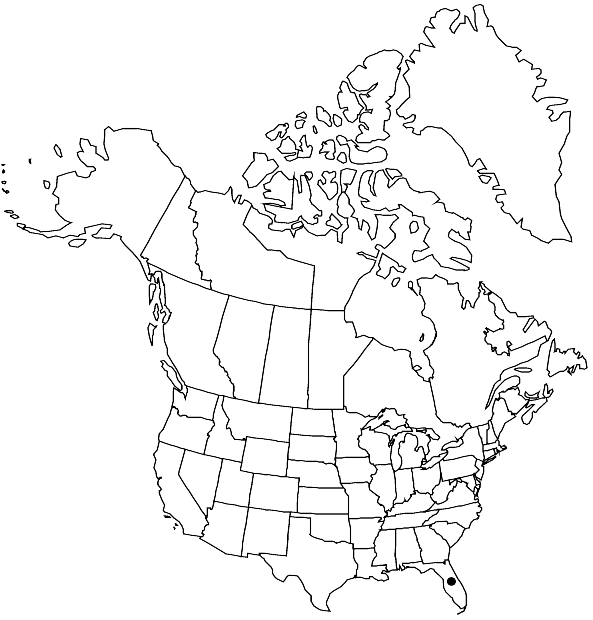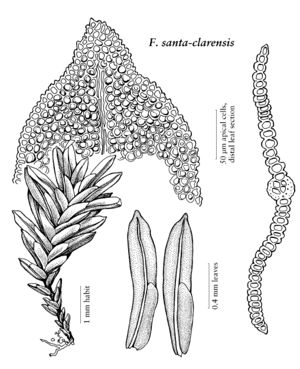Difference between revisions of "Fissidens santa-clarensis"
Mem. Soc. Cub. Hist. Nat. “Felipe Poey” 13: 209, plate 32, fig. 1. 1939,.
FNA>Volume Importer |
FNA>Volume Importer |
||
| Line 23: | Line 23: | ||
|habitat=Rotten wood, bark of living trees, particularly around the base, moist soil, and limestone | |habitat=Rotten wood, bark of living trees, particularly around the base, moist soil, and limestone | ||
|distribution=Fla.;Mexico;West Indies;Central America. | |distribution=Fla.;Mexico;West Indies;Central America. | ||
| − | |discussion=<p>Fissidens santa-clarensis, named for a province in Cuba, is restricted in the United States to peninsular Florida (Citrus, Collier, Dade, Levy, Manatee, Marion, Monroe, Polk, and Sumter counties). The species can be recognized by its abruptly narrowed, rounded-obtuse leaf apex, lenticularly-thickened dorsal and ventral laminal cells, short oblongifolius-type costa that in transverse section of the distal part shows four enlarged cells arranged in two rows, and similiretis-type of peristome. Collections of F. santa-clarensis were long assigned by American authors to F. radicans Montagne, a closely related species with caducous leaves, a broadly acute to rounded leaf apex, and an anomalous peristome with teeth undivided or irregularly divided.</p> | + | |discussion=<p><i>Fissidens santa-clarensis</i>, named for a province in Cuba, is restricted in the United States to peninsular Florida (Citrus, Collier, Dade, Levy, Manatee, Marion, Monroe, Polk, and Sumter counties). The species can be recognized by its abruptly narrowed, rounded-obtuse leaf apex, lenticularly-thickened dorsal and ventral laminal cells, short oblongifolius-type costa that in transverse section of the distal part shows four enlarged cells arranged in two rows, and similiretis-type of peristome. Collections of <i>F. santa-clarensis</i> were long assigned by American authors to F. radicans Montagne, a closely related species with caducous leaves, a broadly acute to rounded leaf apex, and an anomalous peristome with teeth undivided or irregularly divided.</p> |
|tables= | |tables= | ||
|references= | |references= | ||
| Line 45: | Line 45: | ||
|publication year= | |publication year= | ||
|special status= | |special status= | ||
| − | |source xml=https://jpend@bitbucket.org/aafc-mbb/fna-data-curation.git/src/ | + | |source xml=https://jpend@bitbucket.org/aafc-mbb/fna-data-curation.git/src/8f726806613d60c220dc4493de13607dd3150896/coarse_grained_fna_xml/V27/V27_463.xml |
|genus=Fissidens | |genus=Fissidens | ||
|species=Fissidens santa-clarensis | |species=Fissidens santa-clarensis | ||
Revision as of 16:55, 18 September 2019
Plants to 7.5 × 1.5–2.5 mm. Stem unbranched and branched; axillary hyaline nodules absent; central strand present or absent. Leaves as many as 25 pairs, often undulate, oblong-lingulate, abruptly narrowed to rounded-obtuse apex, 1.2–2 × 0.3–0.4 mm; dorsal lamina narrowed proximally, rounded, ending a short distance before insertion; vaginant laminae 1/2–2/3 the leaf length, acute, ± unequal, minor lamina ending near margin; margin crenulate, elimbate; costa ending 4–10 cells before apex, oblongifolius-type, distal part of leaf in transverse section showing 4 enlarged cells arranged in 2 rows; laminal cells in dorsal and ventral laminae 1-stratose, distinct, lenticularly thickened but appearing mammillose, firm-walled, irregularly hexagonal, 6–9 µm, juxtacostal and interior cells of vaginant laminae 1-stratose, smooth, plane, larger; medial marginal cells of vaginant laminae not differing perceptively from interior cells. Sexual condition cladautoicous; perigonia and perichaetia on main stems and branches. Sporophytes 1 per perichaetium. Seta to 4.5 mm. Capsule theca erect, radially symmetric, 0.3–1 mm; peristome similiretis-type; operculum 0.5–0.6 mm. Calyptra 0.7–0.8 mm. Spores 11–15 µm.
Habitat: Rotten wood, bark of living trees, particularly around the base, moist soil, and limestone
Distribution

Fla., Mexico, West Indies, Central America.
Discussion
Fissidens santa-clarensis, named for a province in Cuba, is restricted in the United States to peninsular Florida (Citrus, Collier, Dade, Levy, Manatee, Marion, Monroe, Polk, and Sumter counties). The species can be recognized by its abruptly narrowed, rounded-obtuse leaf apex, lenticularly-thickened dorsal and ventral laminal cells, short oblongifolius-type costa that in transverse section of the distal part shows four enlarged cells arranged in two rows, and similiretis-type of peristome. Collections of F. santa-clarensis were long assigned by American authors to F. radicans Montagne, a closely related species with caducous leaves, a broadly acute to rounded leaf apex, and an anomalous peristome with teeth undivided or irregularly divided.
Selected References
None.
